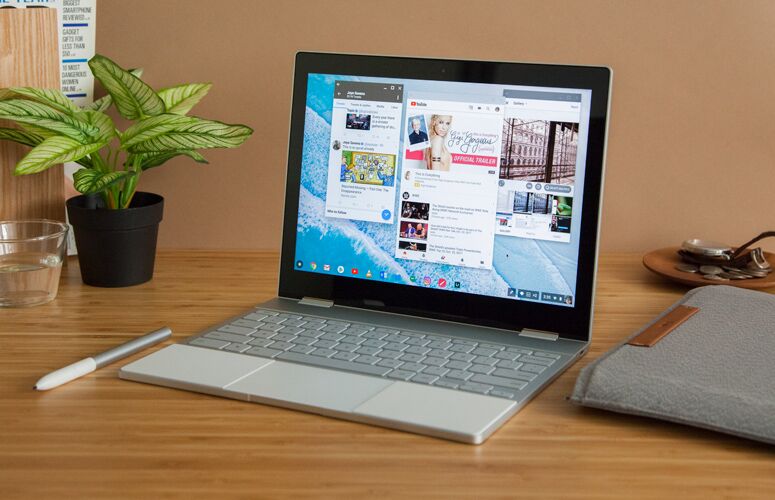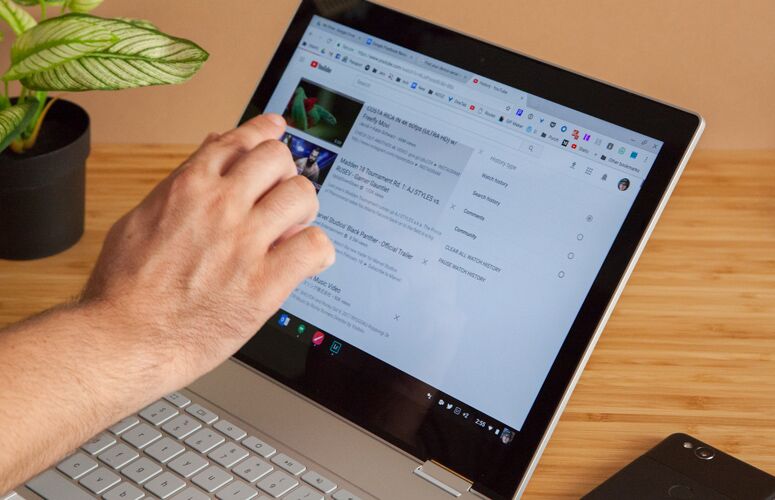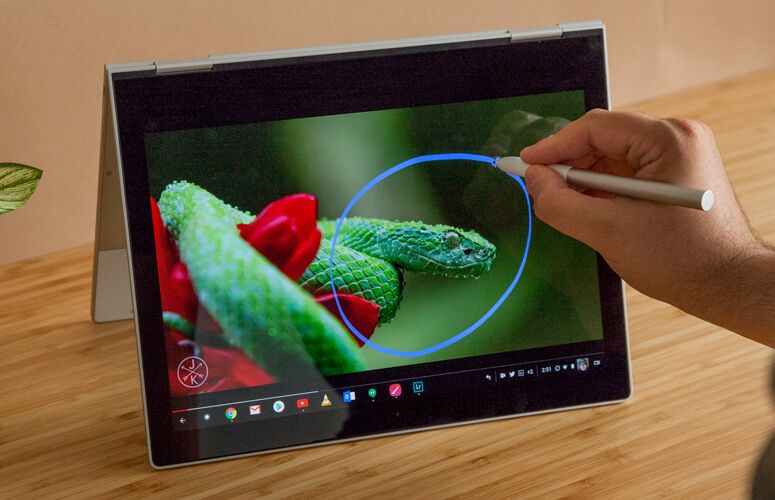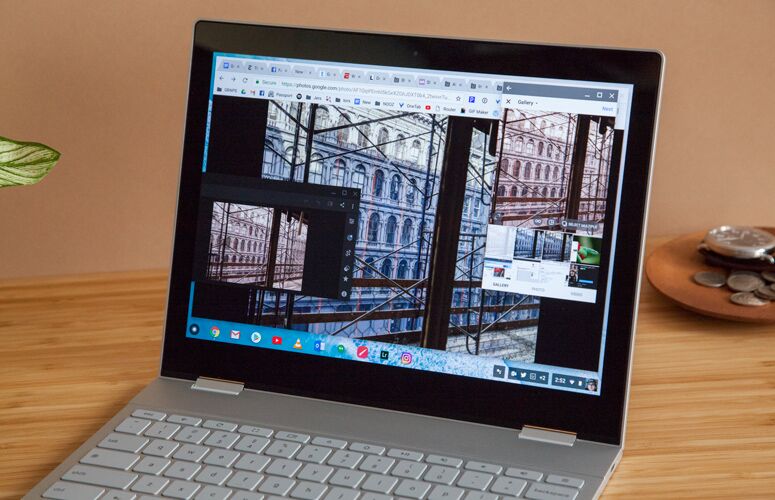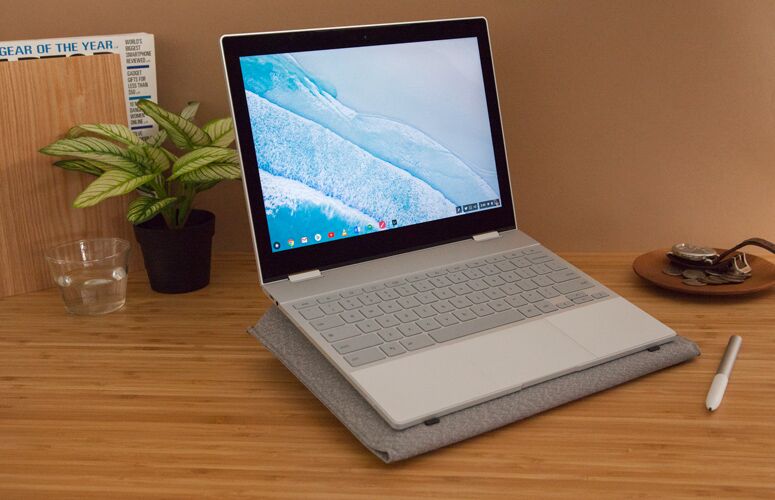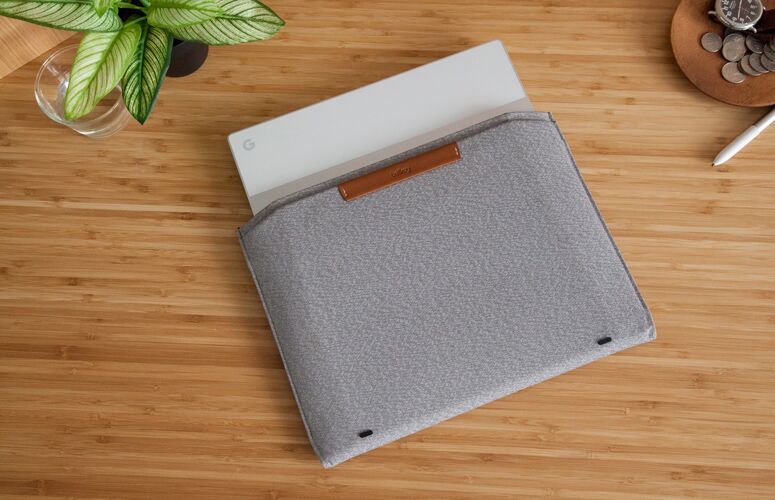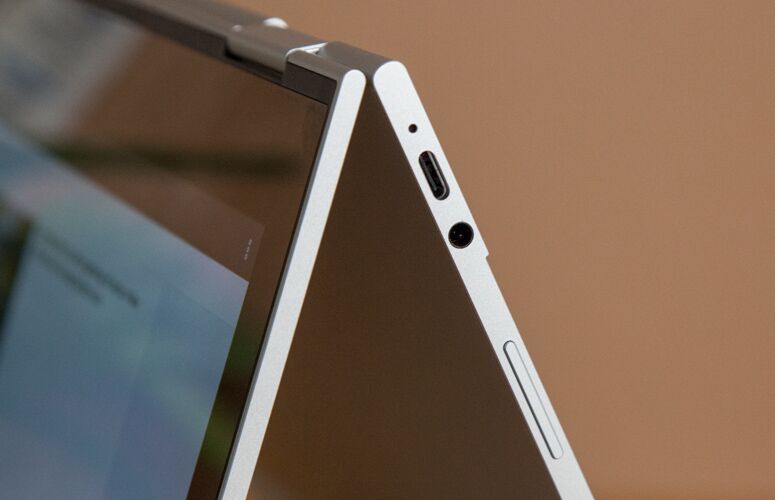Laptop Mag Verdict
The speedy and sexy Google Pixelbook is the best Chromebook, though it comes at a much higher price than we're used to.
Pros
- +
Exquisite thin design
- +
Brilliant display
- +
Speedy performance
Cons
- -
Expensive
- -
Mediocre battery life
Why you can trust Laptop Mag
This review was originally published in October 2017.
Update: We added a durability and drop test section (see below) with results from our Chromebook drop test.
Is $999 too much for a laptop that runs only Chrome OS and Android? The Pixelbook (starting at $999; tested at $1,199) puts that question to the test with its beautiful looks, solid speed and bright, vivid screen. But while it packs impressive fast-charging technology, its battery life falls short of the standard set by other Chromebooks (which typically cost $499 or less). The notebook's true value comes with the recent addition of Android app support, which ties all these features together and makes for a great experience. All of these features tie together in an elegant package that's perfectly suited for business class travelers on the lookout for the best Chromebook.
Design
Kudos, Google. While the Pixelbook's 3:2 aspect ratio may give it a look that sticks out like a square peg in a round hole, this is one of the most attractive machines I've ever tested. Not only is its aluminum unibody design insanely thin, but its silicon wrist rests and accents feel fantastic.
The Pixelbook is so small, in fact, that it doesn't remind me of other tech gadgets but rather an actual paper notebook. Specifically, this marvelously slender laptop evokes those expensive saddle-stitched notebooks that you find only in boutique stationery stores.
Weighing 2.5 pounds and measuring 0.4 inches thick, the Pixelbook is lighter and thinner than the 13.9-inch Lenovo Yoga 920 (3.1 pounds, 0.6 inches) and thinner than the 12.3-inch Samsung Chromebook Pro (2.4 pounds, 0.6 inches) and the 12.5-inch Asus Chromebook Flip C302CA (2.6 pounds, 0.6 inches). The 12.9-inch iPad Pro (2.3 pounds, 0.7 inches when docked with its Smart Keyboard) is lighter but thicker.
Sign up to receive The Snapshot, a free special dispatch from Laptop Mag, in your inbox.
The Pixelbook splits its dual power-drawing USB Type-C ports between its sides, with a headphone jack on the left side.
Durability and drop test
It's not technically rugged but the Pixelbook is the most durable Chromebook you can buy. We dropped 11 of the most popular Chromebooks from heights of 2.5 feet and 4.5 feet onto carpet and concrete, and the Pixelbook came out on top. In fact, Google's laptop looked like it had just been taken out of the box for the first time, even after our brutal side-drop test from 4.5 feet.
Display
We've been trained to believe a 1080p display is the best that Chromebooks deserve, but the Pixelbook's bright, colorful (and nearly quad-HD) 2400 x 1600-pixel panel says that you deserve more. A Black Panther trailer on the Pixelbook's bright, colorful screen showed off plenty of detail on the lively Wakandan streets, vivid blue and purple skies, and the dimpled texture of Erik Killmonger's body.
As a writer, my favorite aspect is possibly the 235-ppi resolution on the 12.3-inch screen, as text in Google Docs and the iA Writer app looked crystal clear. 4K video isn't abundant at the moment, but details in a 4K nature video I streamed on YouTube were wonderfully clear, allowing me to see every scale and bead of water of a luxuriating snake. However, both Google's video player and the VLC video app need a little more tweaking to support 4K video.
The Pixelbook's display is plenty colorful, producing 117 percent of the sRGB spectrum. That's greater than the 101-percent ultraportable-notebook average, as well as the ratings from the Lenovo Yoga 920 (105 percent) and the Asus Chromebook Flip C302CA (76 percent). We saw close scores from the iPad Pro (122 percent) and Samsung Chromebook Pro (118 percent).
This is one of the most attractive machines I've ever tested.
Emitting up to 421 nits, the Pixelbook offers tremendous brightness, which enables strong colors at up to 75 degrees to the left and right. That beats the 290-nit category average, the 284-nit Yoga 920, the 376-nit Samsung Chromebook Pro and the 292-nit Asus Chromebook Flip C302CA. The iPad Pro (555 nits) shines even brighter.
As I navigated the desktop and Chrome apps, I noticed that the Pixelbook's display offered solid touch recognition. Scrolling -- both in apps and TweetDeck -- was smooth, without stutter.
MORE: Google Unveils Pixelbook With Google Assistant
Keyboard and Touchpad
The Pixelbook's backlit keyboard enables comfortable typing for extended periods, despite its thin measurements and shallow design. Testing it out on the 10fastfingers.com typing test, I breezily clicked my way to 76 words per minute, not too far from my 80-wpm average. While its keys have only 0.9 millimeters of travel (we hope for at least 1.5 mm), they feel more comfortable than those on the iPad Pro's Smart Keyboard, which is louder to type on. Google appears to be making up for this shallowness with key mechanisms that require 68 grams of actuation force, beating our 60-gram minimum.
The Pixelbook's silicon palm rest had a grippiness and rubbery flex that made the typing experience more comfortable. Sitting in between those wrist rests is a 4 x 2.6-inch edge-to-edge touchpad that provides accurate tracking and a solid feel to each click. Scrolling through web pages via the touchpad is smooth, and the system offers a three-finger swipe-down gesture so you can see all the Chrome windows and Android apps you have open at once.
Pixelbook Pen
One of the Pixelbook's major features is its Google Assistant-powered Pen, which is, unfortunately, $99 extra. By holding down its button while you circle an object, you send images and text to the digital assistant, which can give you more information.
The Pen's Google Assistant powers are useful when you'd rather circle something than copy and paste it into a new Google search. This came in handy for me when I saw a Facebook post that vaguely referenced swooping season in Australia, which, it turns out, isn't as cute as it sounds.
And just like the $99 Apple Pencil, the Pen features pressure sensitivity and tilt support but this stylus suffers from latency issues depending on where you use it. While the Pen is speedy when you're circling content for Google Assistant searches and doodling in Google Keep, I saw lag when using drawing and writing apps for Android, including Sketchbook, Squid and Infinite Painter. Hopefully, these apps will be optimized for the Pen in the near future.
My most serious gripe about the Pixelbook Pen is that it requires AAAA batteries. They're the kind that are nearly impossible to find in local stores, forcing you to buy them in advance online.
Competitors take different approaches. Lenovo bundles the Active Pen 2 stylus in the Yoga 920's $1,299 price, while the Asus Chromebook Flip includes no stylus at all.
MORE: Pixelbook Hands-On: Google Assistant Comes to Chromebooks
Audio
The Pixelbook can get loud enough to fill a large conference room, but the audio lacks clarity. While listening to Keith Lee's "Ground Zero" and Grandtheft & Keys N Krates' "Keep It 100" via Google Play Music, I admired crisp drums but wondered where the bass went and why vocals sounded so flat.
Performance
Finally, a Chromebook with power. The Pixelbook we tested features a Core i5-7Y57 CPU and 8GB of RAM, enables smooth performance and works well with Android apps. I saw no stutter or lag when splitting my screen between a 1080p YouTube video and a dozen tabs (including Google Docs), all while using the apps for Slack, Twitter and Outlook.
The Pixelbook scored a solid 7,927 on the Geekbench 4 overall performance test, beating the 6,823 ultraportable-notebook average. We saw higher scores of 9,414 from the iPad Pro (A10X Fusion processor, 4GB of RAM) and 13,306 from the Lenovo Yoga 920 (8th-Gen Intel Core i7-8550U, 8GB of RAM).
The Pixelbook earned a score of 145 on the JetStream JavaScript benchmark, which measures the performance of web apps. That's above the 126.6 from the Samsung Chromebook Pro (Core m3-6Y30, 4GB of RAM) and the 127.32 from the Asus Chromebook Flip C302CA (Core m3 6Y30, 4GB of RAM). We saw a higher mark from the Yoga 920 (277.9).
The integrated Intel HD 615 graphics chip in the Pixelbook powered its smooth visuals on the WebGL Aquarium test, where it rendered 2,000 fish at a rate of 60 frames per second. That's better than the 48 fps from the Samsung Chromebook Pro (Intel HD Graphics 615) and the 50 fps from the Asus Chromebook Flip C302CA (Intel HD Graphics 515). The ultraportable-notebook average is a higher 269 fps.
MORE: Best 2-in-1s (Laptop/Tablet Hybrids)
Battery Life
Chromebooks often offer terrific battery life, but yet again, the Pixelbook isn't your average Chrome OS laptop. The notebook lasted only 7 hours and 43 minutes on the Laptop Mag Battery Test (web surfing over Wi-Fi), which is shorter than the 8:34 category average, as well as the times from the iPad Pro (12:09), the Lenovo Yoga 920 (12:22), the Samsung Chromebook Pro (8:05) and the Asus Chromebook Flip (8:52).
While Google promotes the Pixelbook's fast-charging battery, its claim of up to 2 hours of use after 15 minutes of charging (when the notebook has at least 5 percent of its battery life left) didn't bear out in my testing. After charging for those 15 minutes, I managed to eke out 1 hour and 18 minutes from the Pixelbook, though my activity mixed both Chrome web surfing and Android app usage.
Chrome OS
The Pixelbook is one of the few, the proud and the fortunate of its brethren with decent apps. The long-running issue with Chromebooks was that they couldn't compete with Windows or macOS machines because they were limited to apps from the Chrome Web Store, which is about 95 percent junk.
Now, by bringing the Google Play store and its Android apps to the platform -- a long-promised change that's finally taking place this year on select machines, including the Samsung Chromebook Pro and the Asus Chromebook Flip -- the Chromebook has a better chance of competing. Now you can get Microsoft Office apps (Outlook runs well), password managers (including my favorite, 1Password), games like PinOut and actual Instagram (complete with posting, which even Macs and PCs can't claim).
The addition of Android finally gives Chromebook buyers a reason to consider significantly larger storage options thanks to apps that save content for offline usage. Those include the Netflix app's ability to save TV shows and Spotify Premium's power to keep playlists for later. I found the option to store my favorite podcasts (in Pocket Casts) particularly compelling.
A Black Panther trailer on the Pixelbook's bright, colorful screen showed off plenty of detail on the lively Wakandan streets.
Photo editing is also better now, since the addition of the Google Play store brings Android's superior apps (versus the Chrome Web Store's junk drawer), including Adobe Photoshop Lightroom. And because Instagram works on the Pixelbook, you can sync images among devices (Google will suggest its Photos app, which is a solid option), edit and tweak images on the notebook's larger screen, and post to Instagram via its Android app on your Pixelbook. Go ahead, use the #NoFilters hashtag; we won't tell.
One of the arguable perks of Chrome OS is that Google handles all of the security updates on the back end. The Pixelbook also features TPM technology so you can encrypt your most important data.
The Pixelbook rewards people ensconced in the Google hardware ecosystem with Instant Tethering, which automatically turns Pixel and Nexus phones into hotspots for the notebook if it loses its Wi-Fi connection. The devices need to be signed in to the same Google account, for the sake of security.
Frustratingly, some apps still need to be rewritten to be ready for Chrome OS notebooks. Many (Instagram and Facebook included) don't support the up and down arrows for scrolling, and Snapchat needs to be adjusted so that it doesn't rotate the camera to a 90-degree angle.
But you know who doesn't have to deal with unfinished touch interfaces? People with iPads and 2-in-1s running Windows; they have a great touch experience, since both platforms have been optimized for taps and styli for years, and have only been gaining tricks with Windows 10 and iOS 11.
Webcam
Everything about the Pixelbook feels premium except its pedestrian 0.9-megapixel webcam. Sure, the selfie I shot with the notebook delivered accurate greens in our office's rooftop shrubbery and the reds of my T-shirt, but the leaves of those plants and most of the strands in my hair were lost in blurriness.
Heat
The Pixelbook stays cool, except on one spot. After we streamed 15 minutes of video on the notebook, our heat gun captured temperatures on its touchpad (84 degrees Fahrenheit), the center of its keyboard (89 degrees) and underside (95 percent) that did not exceed our 95-degree comfort threshold. But when we closed it and picked it up by the edge where its hinges are, we noticed an even hotter point, which we measured at 101 degrees.
Configuration Options and Accessories
We tested the $1,199 Pixelbook, which includes a Core i5-7Y57 CPU, 8GB of RAM and 256GB of storage. The cheaper $999 model halves the storage to 128GB, and a Core i7 model with 16GB of memory and 512GB of storage will cost $1,649 when it's released at a to-be-determined date.
Google partnered with the wallet-maker Bellroy (I use and love its minimalist Card Sleeve wallet) for the $89 Sleeve case. At first, I was puzzled by the sleeve, as it's sized a bit too small to slide the Pixelbook out comfortably.
The Bellroy sleeve also offers a wedge mode that lets you to turn it into a stand, elevating the screen closer to eye level and allowing you to type on keys raised at an angle, which can prove more comfortable. Frustratingly, the wedge position requires you to fold a flap inside the sleeve to a position that doesn't quite feel natural or correct.
Bottom Line
The Pixelbook's aesthetics, performance and display are great for a Chromebook, but they also stack up well against Windows- and iOS-powered competitors. If not for its higher price and subpar battery life, the Pixelbook would be an easy recommendation.
You can save $500 and gain more than an hour of battery life with the Asus Chromebook Flip C302CA, but that machine isn't as fast or nearly as sexy (but what Chromebook is?). For the same price as the $1,299 Pixelbook with its Pen, you can get the much faster Lenovo Yoga 920 and the additional functionalities of Windows 10 (though, if you're looking for a Chromebook, you probably prefer Google's OS). And with the addition of its Keyboard Cover and Pencil, the iPad Pro is a comparable $1,290 and offers a far brighter display and iOS 11, which is built for increased productivity.
But if money's no option, the Google Pixel is the best damn Chrome OS machine you'll find because it provides a level of usability, performance and style you won't find on any other Chromebook.
Credit: Shaun Lucas/Laptop Mag
- Best Laptops for College Students
- Our Favorite Tablets for Work and Play
- The Best Laptops for Every Need
Google Pixelbook Specs
| CPU | Core i5-7Y57 |
| Display Size | 12.3 |
| Hard Drive Size | 256GB |
| Hard Drive Type | eMMC |
| Highest Available Resolution | 2400 x 1600 |
| Native Resolution | 2400 x 1600 |
| Operating System | Google Chrome |
| RAM | 8GB |
| RAM Upgradable to | 16GB |
Henry was a contributing writer at Laptop Mag. He penned hundreds of articles, including helpful how-tos for Windows, Mac, and Gmail. Henry has also written about some of the best Chromebooks, and he has reviewed many Apple devices, including various MacBook Air laptops. He is now a managing editor at our sister site Tom's Guide, covering streaming media, laptops, and all things Apple.
